 After a burst of activity I have finalized the guest line-up for June and July and next week it’s the Summer 2017 Sofa Spotlight – a full dozen titles as in previous years (so much for my intention to scale back by doing it quarterly). I am honoured that so many incredible writers contribute to the blog, and to introduce acclaimed Canadian author Elizabeth Hay as today’s guest. Elizabeth has published a memoir, three collections and five novels including Late Nights on Air which was awarded Canada’s prestigious Giller Prize in 2007. Her most recent release, His Whole Life, one of my Spring Sofa Spotlight titles, is a ‘quiet novel’ of the kind which doesn’t always get the attention it deserves, but many of you share my love for these books and it’s always a delight to feature them. Foremost amongst its qualities (of which you can discover more in my review below) is an extraordinary sense of place – and that’s where we’re headed right now:
After a burst of activity I have finalized the guest line-up for June and July and next week it’s the Summer 2017 Sofa Spotlight – a full dozen titles as in previous years (so much for my intention to scale back by doing it quarterly). I am honoured that so many incredible writers contribute to the blog, and to introduce acclaimed Canadian author Elizabeth Hay as today’s guest. Elizabeth has published a memoir, three collections and five novels including Late Nights on Air which was awarded Canada’s prestigious Giller Prize in 2007. Her most recent release, His Whole Life, one of my Spring Sofa Spotlight titles, is a ‘quiet novel’ of the kind which doesn’t always get the attention it deserves, but many of you share my love for these books and it’s always a delight to feature them. Foremost amongst its qualities (of which you can discover more in my review below) is an extraordinary sense of place – and that’s where we’re headed right now:
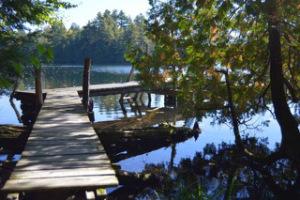
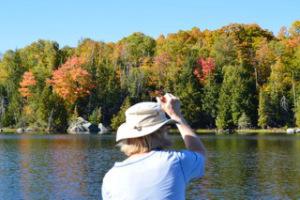
My small fictional family, with its Canadian mother and American father, is on their annual summer pilgrimage from New York City to visit the Canadian side of the family. They arrive at the lake of many bays in eastern Ontario and their reactions tell us who they are. Nan, the homesick mother, embraces the Canadian space and light. George, the father, a New Yorker through and through, wants no part of the place. Jim, their ten-year-old son, views the lake through New York eyes that are eager to love it for his mother’s sake.
And so Jim finds himself taking sides. Turning to his mother’s brother, Jim asks him why he likes it here so much and his uncle gives him a satisfying reply. “The quiet, first of all. The quiet, the size of the trees, the animals, the canoes.”
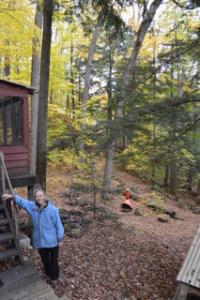
The lake that gave me the ingredients for my fictional lake of many bays is about two hours by car from my home in Ottawa. The musty, smoky, refrigerated reality consists of a primitive one-room cabin with a screened-in porch, no electricity, no plumbing, a woodstove, a privy out back, a long steep slope down to the water where we have a home-made dock that resembles a weathered log. When my formidable parents built the cabin, the whole place was oppressive to me: dank, dark, claustrophobic. Only when I brought my American husband along one August, and saw him fall in love at first sight, did the scales fall from my eyes. And what did Mark like? “The quiet, first of all. The quiet, the size of the trees, the animals, the canoes.” We too are a cross-border family, my Massachusetts-born second husband and I.
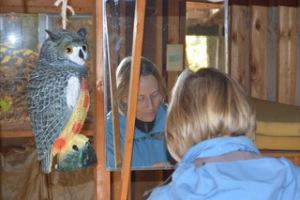
September 11, 2008. Rising in the dark and taking the canoe out under starlight, the more than half moon of last night having set. Down the slope by flashlight to the water and first dawn. Mark still abed. And by canoe out into another world – the shore dark, the islands jet-black, the water still. Some mist rising. I paddle around the corner and almost immediately the slap of a beaver – more than one. I stop paddling and linger here to watch the advancing light, hear owls in the distance, loons in the distance, beaver-gnawing behind me. The lower sky begins to ripen into a subtle peach. The peach gathers strength. I look at my watch. 6:10. Then the raven speaks. And speaks again from the treetop on the island to the right. Then takes off through the trees, croaking and talking.
To be at the lake is to be reminded of so much – the living past, the changing seasons, my ever-changing feelings about my mother and father, my grief that they are gone and soon enough I’ll be gone too. As the Swedish poet Tömas Transtromer wrote, “The greenery is dense / with memories, they follow me with their gaze.”
Thank you to Elizabeth, for a beautiful post which conveys the power of a deep personal connection to place, and what this can bring to a work of fiction.
I’d love to hear about some of your favorite ‘quiet novels’ and stories in which the natural world plays a big part.
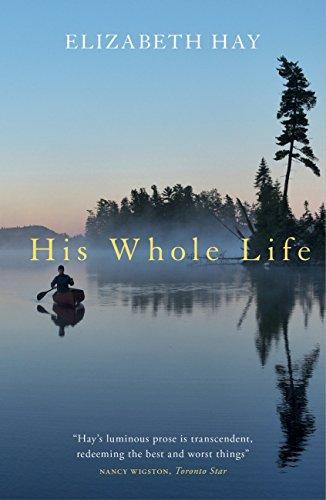
(See the Sofa Spotlight for a description of the book)
At the start of this story of fractured love and divided loyalties, ten-year-old Jim asks his parents a question which will reverberate throughout: ‘What’s the worst thing you’ve ever done?’ This is the catalyst for a moving and often painful exploration of guilt, regret, memory, but above all, the nature and complexity of human bonds, of many kinds. The mother-son relationship between Jim and Nan is drawn with a tenderness and poignancy which I found intensely recognisable; an adolescent boy is not an easy being to capture but I believed Jim, although his unusual maturity does become more convincing as the years go by. The question of whether life’s adversities ultimately define, shape or destroy us is a fascinating one. Conversely, the second Quebec Independence referendum over 20 years ago might seem an obscure subject to non-Canadians but for me the intended parallels (with family conflict) were upstaged by the uncanny and unforeseeable relevance this book has acquired for Britons and other EU Citizens in the Brexit era, as we prepare for a separation many do not want. For a story so concerned with ‘interior life’, it has the most powerful, transporting sense of the wild, big skies and wide open spaces and the two elements are indivisible: the scene which had me in tears could not have taken place anywhere else. The lake’s meaning for the characters rubs off on the reader – everything feels different there, showing what a ‘change of scenery’ can do. The cover of the UK paperback (which I only saw after reading) captures the essence of this emotionally intelligent and exquisitely written novel to perfection – I can’t wait to read more of Elizabeth Hay’s work.
Advertisements
